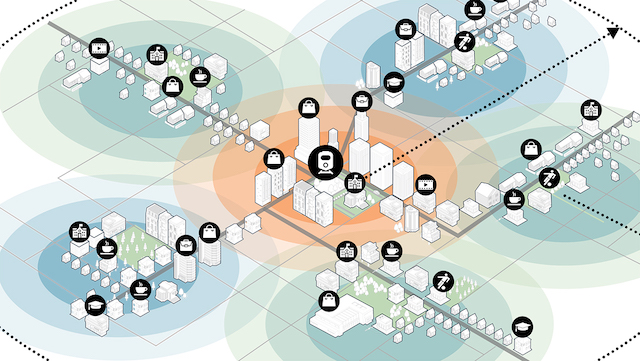As if the 15-minute city wasn’t bad enough, planners are now promoting what they call the 20-minute suburb. According to its supporters, suburbanites are fed up with driving everywhere and are demanding that the suburbs be rebuilt at higher densities with lots of “town centers” so that everyone can walk to a shop in 20 minutes.
Skidmore, Owings & Merrill concept for denser, 20-minute suburbs with lots of transit.
How do planners know this? Because during the height of the pandemic, a lot of people bought bicycles causing, for a brief time, a bicycle shortage. Based on this and similar anecdotal information, planners agree that the time is ripe to completely rebuilt the nation’s suburbs by eliminating single-family zoning and building lots of dense mixed-use developments.
These are not new ideas. Instead, like the 15-minute city, these are just the same tired old New Urbanist ideas with a catchy new name.
Back in 1993, the Congress for the New Urbanism wrote a manifesto stating that “All development should be in the form of compact, walkable neighborhoods.” To achieve that, the group supported “the reconfiguration of sprawling suburbs into communities of real neighborhoods.” It didn’t matter whether people wanted those things or not; the planners knew better than residents and should be allowed to steamroll over existing neighborhoods to get what they want. (Needless to say, libertarians who support the abolition of single-family zoning are effectively supporting these central planners.)
The reality is that the planners talking about 20-minute suburbs are reading their own preferences into the anecdotal data they cite. Let’s see what’s really happening.
Census Bureau data show that, in 2019, almost 4.2 million people walked to work and more than 800,000 rode bicycles. In 2021, the number of people walking to work declined to 3.4 million while the number riding bicycles fell to just over 600,000. That doesn’t make it sound like there is a huge demand for walkable neighborhoods. Meanwhile, other data indicate that people working at home are driving more miles each day than when they commuted to work at another job site.
Proposals to increase transit in the suburbs are similarly bankrupt (or will make taxpayers bankrupt). Almost 7.8 million people took transit to work in 2019, but this fell to just 3.8 million in 2021. Judging by transit’s minimal recovery since 2021, the number who took transit was still well below 5 million in 2022 and will probably remain so in 2023.
Of course, the planners claim this is all for the benefit of planet earth, which is otherwise doomed by our greenhouse gas emissions. We could respond that it would be far less expensive and less disruptive to encourage everyone to buy electric cars, but they are already demonizing electric vehicles for being too heavy and therefore too dangerous to put on city and suburban streets.
Although planners’ ideas are absurd, there is also a fundamental contradiction in the notion that we should have 15-minute cities but 20-minute suburbs. The 15-minute city idea can be traced back to at least 2014 when planners began talking about 30-minute cities. But then planners realized that most Americans won’t walk 30 minutes anywhere, so they cut it to 15 minutes (which also gave them justification for even more densification).
So if people in cities won’t walk more than 15 minutes, why would planners think that suburbanites will walk 20? For a long time, the planning mantra has been that suburbanites are fat and lazy and that’s why they drive everywhere. Now suddenly they are supposed to be willing to walk one-third greater distances than city dwellers?
The truth is that none of these ideas add up. Before the pandemic, Americans drove for more than 97 percent of urban travel, and since the pandemic driving’s share has been even higher. Completely rebuilding cities and suburbs to cater to the 2 percent or so who don’t drive while penalizing the 97 to 98 percent who do makes no sense. But what do you expect from central planners who think they know how everyone else should live and are willing to use any means to impose those ideas on the rest of us?









Perhaps all these planners should move to a country that already has central planning … or at least point us to a centrally planned country that has a happy and prosperous population.
Who decided on 20 minutes as opposed 15. As of they anticipate there will be traffic delays
Too often, the “15-minute city” is just a slogan. A better understanding of the 15-minute city, with its walking and bicycling sheds, is critical to achieving the benefits of placing human access at the heart of community planning.
https://www.cnu.org/publicsquare/2022/12/13/slogan-substance-planning-15-minute-city
It appears that the job of the 15 minute city is to eliminate automobiles — but if automobiles are all battery powered EVs, there is no need to eliminate them and therefore no need for the 15 minute city.
im not sure how miserable the dutch are.
”
So if people in cities won’t walk more than 15 minutes, why would planners think that suburbanites will walk 20? For a long time, the planning mantra has been that suburbanites are fat and lazy and that’s why they drive everywhere. Now suddenly they are supposed to be willing to walk one-third greater distances than city dwellers?
” ~anti-planner